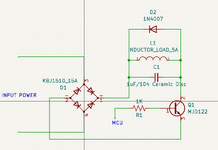venkates2218
Full Member level 6
Hello friends
Please see the picture that is attached.
The load may be turned ON/OFF with a 100ms delay based on the controller's signal.
Instead of a mechanical relay, we used an NPN transistor.
It is now operating OK, however the bridgre rectifier temperature is occasionally rising when the load is switched ON
How can I fix the heating problem on the rectifier?
Please see the picture that is attached.
The load may be turned ON/OFF with a 100ms delay based on the controller's signal.
Instead of a mechanical relay, we used an NPN transistor.
It is now operating OK, however the bridgre rectifier temperature is occasionally rising when the load is switched ON
How can I fix the heating problem on the rectifier?
